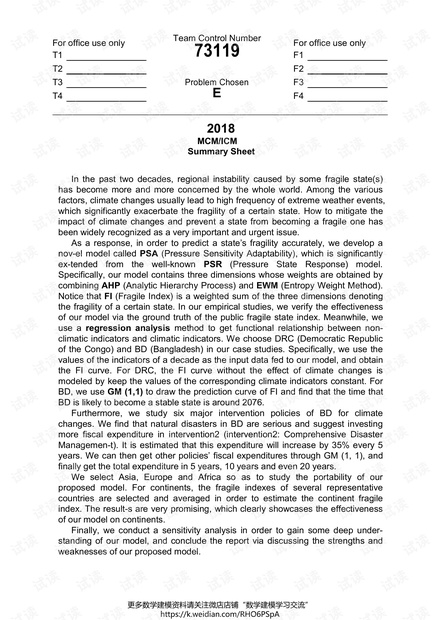没有合适的资源?快使用搜索试试~ 我知道了~
资源推荐
资源详情
资源评论

For office use only
Team Control Number
For office use only
73119
T1 F1
T2 F2
T3
Problem Chosen
F3
T4
E
F4
2018
MCM/ICM
Summary Sheet
In the past two decades, regional instability caused by some fragile state(s)
has become more and more concerned by the whole world. Among the various
factors, climate changes usually lead to high frequency of extreme weather events,
which significantly exacerbate the fragility of a certain state. How to mitigate the
impact of climate changes and prevent a state from becoming a fragile one has
been widely recognized as a very important and urgent issue.
As a response, in order to predict a state’s fragility accurately, we develop a
nov-el model called PSA (Pressure Sensitivity Adaptability), which is significantly
ex-tended from the well-known PSR (Pressure State Response) model.
Specifically, our model contains three dimensions whose weights are obtained by
combining AHP (Analytic Hierarchy Process) and EWM (Entropy Weight Method).
Notice that FI (Fragile Index) is a weighted sum of the three dimensions denoting
the fragility of a certain state. In our empirical studies, we verify the effectiveness
of our model via the ground truth of the public fragile state index. Meanwhile, we
use a regression analysis method to get functional relationship between non-
climatic indicators and climatic indicators. We choose DRC (Democratic Republic
of the Congo) and BD (Bangladesh) in our case studies. Specifically, we use the
values of the indicators of a decade as the input data fed to our model, and obtain
the FI curve. For DRC, the FI curve without the effect of climate changes is
modeled by keep the values of the corresponding climate indicators constant. For
BD, we use GM (1,1) to draw the prediction curve of FI and find that the time that
BD is likely to become a stable state is around 2076.
Furthermore, we study six major intervention policies of BD for climate
changes. We find that natural disasters in BD are serious and suggest investing
more fiscal expenditure in intervention2 (intervention2: Comprehensive Disaster
Managemen-t). It is estimated that this expenditure will increase by 35% every 5
years. We can then get other policies’ fiscal expenditures through GM (1, 1), and
finally get the total expenditure in 5 years, 10 years and even 20 years.
We select Asia, Europe and Africa so as to study the portability of our
proposed model. For continents, the fragile indexes of several representative
countries are selected and averaged in order to estimate the continent fragile
index. The result-s are very promising, which clearly showcases the effectiveness
of our model on continents.
Finally, we conduct a sensitivity analysis in order to gain some deep under-
standing of our model, and conclude the report via discussing the strengths and
weaknesses of our proposed model.
更多数学建模资料请关注微店店铺“数学建模学习交流”
https://k.weidian.com/RHO6PSpA

Keywords: Fragile State, Climate Change, PSA, GM (1,1)

Team # 73119 Page 1 of 22
Contents
1 Introduction 2
1.1 Background . . . . . . . . . . . . . . . . . . . . . . . . . . . . . . . . . . . 2
1.2 Restatement of Problems . . . . . . . . . . . . . . . . . . . . . . . . . . . . 2
1.3 Our Work . . . . . . . . . . . . . . . . . . . . . . . . . . . . . . . . . . . . . 3
2 Assumptions and Symbol Table 3
2.1 Assumptions . . . . . . . . . . . . . . . . . . . . . . . . . . . . . . . . . . . 3
2.2 Symbol Table . . . . . . . . . . . . . . . . . . . . . . . . . . . . . . . . . . . 4
3 Model PSA 4
3.1 PSR . . . . . . . . . . . . . . . . . . . . . . . . . . . . . . . . . . . . . . . . 4
3.2 PSA . . . . . . . . . . . . . . . . . . . . . . . . . . . . . . . . . . . . . . . . 4
3.2.1 Identify indicators . . . . . . . . . . . . . . . . . . . . . . . . . . . 5
3.2.2 Data Pre-processing . . . . . . . . . . . . . . . . . . . . . . . . . . 6
3.2.3 Data Normalization . . . . . . . . . . . . . . . . . . . . . . . . . . 6
3.2.4 Calculate weight by AHP . . . . . . . . . . . . . . . . . . . . . . . 7
3.2.5 Calculate weight by EWM . . . . . . . . . . . . . . . . . . . . . . . 7
3.2.6 Weighted average . . . . . . . . . . . . . . . . . . . . . . . . . . . .
8
3.3 Analyze direct and indirect impacts of climate change . . . . . . . . . . . 8
3.4 Test PSA . . . . . . . . . . . . . . . . . . . . . . . . . . . . . . . . . . . . . 10
4
Case Study
12
4.1 Study 1: Democratic Republic Of the Congo . . . . . . . . . . . . . . . . . 12
4.1.1
Climate change effects of Congo . . . . . . . . . . . . . . . . . . . 12
4.1.2
The FI without climate change effects . . . . . . . . . . . . . . . . 12
4.2 Study 2: People’s Republic of Bangladesh . . . . . . . . . . . . . . . . . . 13
4.2.1 Climate change effects of Bangladesh . . . . . . . . . . . . . . . . 13
4.2.2 Prediction . . . . . . . . . . . . . . . . . . . . . . . . . . . . . . . . 15
4.2.3 Effect of Human Intervention . . . . . . . . . . . . . . . . . . . . . 15
4.2.4 Total cost . . . . . . . . . . . . . . . . . . . . . . . . . . . . . . . . . 16
5 Further Exploration 17
6 Sensitivity Analysis 17
7 Strengths and Weaknesses 18
7.1 Strengths . . . . . . . . . . . . . . . . . . . . . . . . . . . . . . . . . . . . . 18
7.2 Weaknesses . . . . . . . . . . . . . . . . . . . . . . . . . . . . . . . . . . . 19
8 Conclusions 19
Appendices
21
Appendix A FI of Country
21

Appendix B Climate expenditure of Bangladesh
22
Team # 73119 Page 2 of 22
1 Introduction
1.1 Background
In the past 20 years, there have been local wars and conflicts in the world and the fragile
states have been a threat to the world security. Therefore, fragile states become a major
issue for the world’s development. OECD (Organization for Economic Co-operation and
Development) defines "States are fragile when state structures lack political will and/or
capacity to provide the basic functions needed for poverty reduction, develop-ment and
to safeguard the security and human rights of their populations."[1] Many universities and
research institutes start to research centers to specialize in problems of fragile states. To
measure fragility of a state, many evaluation indexes have been put forward, such as
World Bank’s Country Policy and Institutional Assessment (CPIA) [2], Carton University’s
Country Indicators for Foreign Policy Fragility Index (CIFP)[3]and The Fund for Peace’s
Fragile States Index (FSI)[4]. Nowadays, due to the rapid devel-opment of industries and
the rapid increase of population, large amount of energy consumption and greenhouse
gases emission like carbon dioxide cause global warm-ing, then the frequent extreme
weather and even the more extreme phenomena like a colder winter and a hotter
summer. The climate change leads to more frequent and more serious drought, flood,
storm, coldness and hotness, and leads to decline of wa-ter, food and energy[5], and
then even leads to the wide spread of famine and diseases. If the government is unable
to solve the problem of famine and diseases for people, there will be local violent
conflicts. If the foreign government interferes in internal af-fairs, there will be wars and
regional instability. Without effective measures to solve these problems, there will be
disasters which bring threats to the world’s peace and de-velopment. Hence, reducing
the fragility of a state has its unprecedented significance in today’s world.
1.2 Restatement of Problems
To create a more stable world, fragile state should be studied first and the following
tasks are to be accomplished:
An evaluation index system to evaluate a state’s fragility and measure the influ-
ences of climate change on fragility is needed. By considering various factors
like economy, society, politics and local climate, the model should clearly extin-
guish the state is fragile, vulnerable or stable. Meanwhile the model can identify
how climate change increases fragility through direct means or indirectly as it
influences other indicators. (Refer to Task1)
The influence of climate change on state should be evaluated, which help find
out some definitive indicators. (Refer to Task2 and Task 3)
The risks of current national policies about reducing climate change, the effect
of protecting the state from being fragile as well as the total cost should be
evaluat-ed. (Refer to Task4)

Adjust the model and make it adaptable to cities and continents.(Refer to Task5)
剩余26页未读,继续阅读
资源评论


matlab科研助手
- 粉丝: 3w+
- 资源: 5991
上传资源 快速赚钱
 我的内容管理
展开
我的内容管理
展开
 我的资源
快来上传第一个资源
我的资源
快来上传第一个资源
 我的收益 登录查看自己的收益
我的收益 登录查看自己的收益 我的积分
登录查看自己的积分
我的积分
登录查看自己的积分
 我的C币
登录后查看C币余额
我的C币
登录后查看C币余额
 我的收藏
我的收藏  我的下载
我的下载  下载帮助
下载帮助

 前往需求广场,查看用户热搜
前往需求广场,查看用户热搜最新资源
- 电动汽车空调制冷系统电动压缩机匹配分析1.pdf
- 二氧化碳汽车空调系统设计及研究1.pdf
- 电动汽车驱动系统散热设计与试验验证.pdf
- McQuayDuctSizer(麦克维尔风管尺寸计算软件).zip
- 麦克维尔温湿度分析仪McQuayPsychrometricAnalyzer(hvac-eng.com).zip
- 麦克维尔管道测量仪McQuaypipesizer .zip
- 信捷XC系列PLC主从通讯程序
- 基于蒙特卡洛的电动汽车充电负荷生成
- 基于遗传算法的电动汽车有序充电优化调度 软件:Matlab 利用遗传算法对电动汽车有序充电进行优化;优化目标包括充电费用最低,充电时间达到要求(电动汽车充到足够的电)考虑电动汽车充电对电网负荷的影响
- FPGA 全部verilog代码实现I2C口master端口应用场景 1、FPGA通过I2C口配置TFP410MP 2、EDID配置,FPGA通过I2C口配置AT24C02 AT24C64; 访问地
- Matlab simulink 基于光伏和蓄电池的三端口
- FFT STM32+apFFT程序源代码+lunwen资料+教程讲解 适用于STM32F103平台,使用AD7606同步采集两路正弦信号,内置1024点全相位快速傅里叶变(apFFT)算法,直接计算
- 两电平svpwm算法verilog程序
- 基于改进的快速粒子群有源配电网动态无功优化 软件:Matlab 介绍:在含分布式电源的IEEE33进行无功优化,以无功最优和运行费用最优为目标函数进行优化,采用改进的快速粒子群算法进行计算
- 混合型APF,HAPF,电力牵引系统电能质量控制,高铁谐波补偿,高铁无功补偿,混合型有源电力滤波器,单相SVG,SVG,电力牵引系统谐波无功补偿
- 单机无穷大系统静态稳定性仿真模型
资源上传下载、课程学习等过程中有任何疑问或建议,欢迎提出宝贵意见哦~我们会及时处理!
点击此处反馈



安全验证
文档复制为VIP权益,开通VIP直接复制
 信息提交成功
信息提交成功